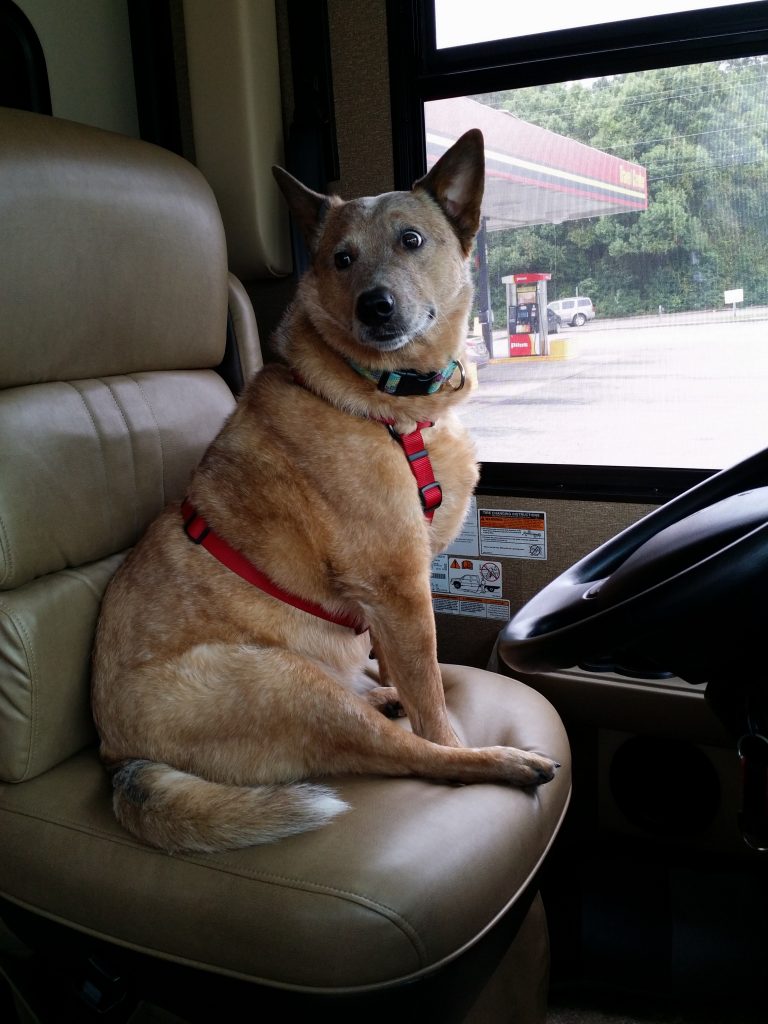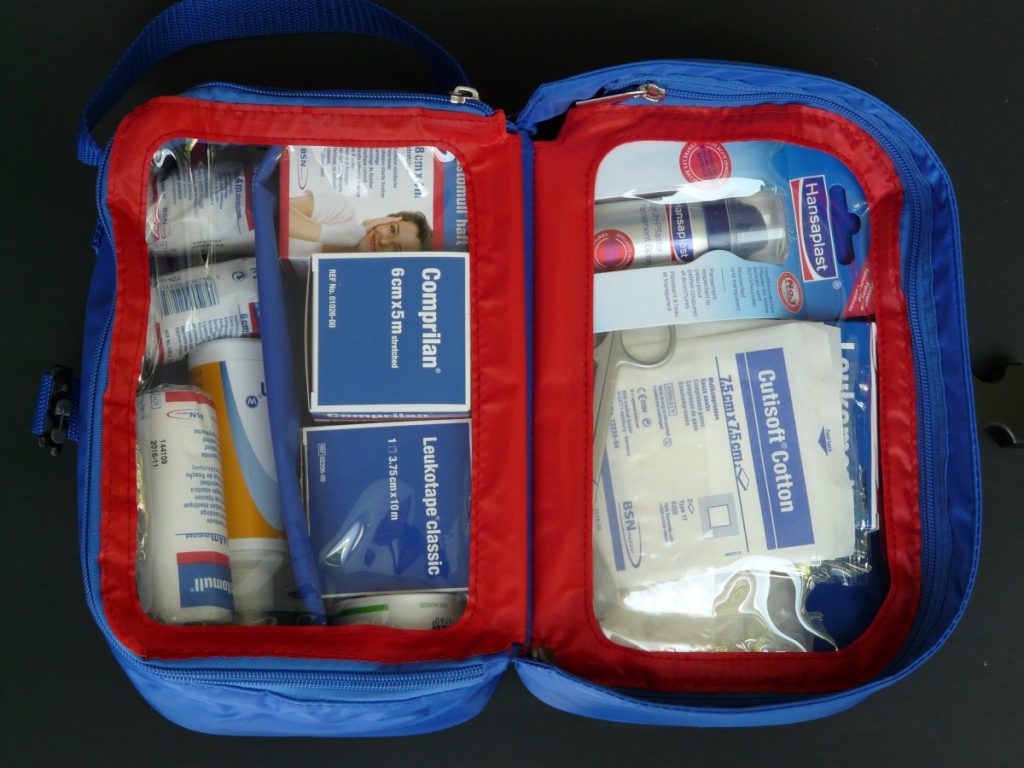Having the ability to bring your canine companions on the road to share your adventures is one of life’s great joys, and for many of us, one of the reasons you have a furry buddy.
Dogs make great hiking, biking, running, canoeing, camping, swimming, skiing, sledding, Frisbee, you-name-it buddies, and being active is good for both human and canine friends. However, with fun and adventure comes a certain level of risk that you need to be prepared for—cuts, sprains, and other injuries can happen to your buddy as well as to yourself during any outing, and can be of particular concern if you are on the road away from your regular veterinarian’s care.
It is good practice to have some sort of first aid kit on hand that can be available if something happens to you or your dog while you are off having fun.

Traveling with your dog is one of the joys of being on the road! (Photo by IRV2.com member Hondavalk)
There are all sorts of pre-packaged first aid kits that you can get online or in stores that make good starting points. Most (but not all) of the items that are sold for humans can also be used for dogs.
You need to be aware that many over-the-counter medications (such as Ibuprofen) that are safe for humans can be very toxic to animals, and should not be given to them. In addition, some medications that can be given to dogs cannot be given to cats.
Of course, a human-sized Band-Aid isn’t going to be very helpful for an injury on your German Shepherd, so any first aid kit will need a certain level of modification to fit your needs.
The best place to start is a chat with your veterinarian
A good relationship between a pet owner and their veterinarian is the best bet to ensure the overall health of any animal. Your vet knows the specific needs that your dog has, and can help you find items to include in your kit for your dog, the duration of your trip, and the activities you are planning.

Photo by Barbara2112, Flickr
They can also identify items in your kit that should NOT be used on dogs, which you might want to mark down so that in the future you can easily identify and avoid them.
Ask yourself before your trip:
- What sort of trip are you planning?
- How long of a trip are you expecting?
- What type of injury might occur?
- Where are the closest resources you can turn to for help?
- Will you be within cell phone range?
- Do you have local veterinary numbers written down?
- Does your dog have special medication or medical needs to plan for?
- Are there particular environmental conditions (extreme heat, cold, remoteness, noise, poisonous plants/animals, etc.) to take into consideration?
- Are there any special logistics, vaccinations, or medications you may need where you are going (ie international travel, or areas where there may be parasites that you do not have in your area, such as fleas, heartworm, ticks, etc.)?
These questions are important to consider for every outing you take. A long weekend trip near your home requires a different level of preparedness than a multi-month adventure across the US with your dog, for example.
Once you have an idea of the scope of your trip, you can better plan what you may need as far as first aid. It may be useful to have several different first aid kits assembled for a range of adventures you may have planned.

Once you have your materials gathered, you need a convenient way to store them. A toiletry travel bag or an old “bum bag” can be used as an easy grab-and-go first aid kit.
For larger adventures, you might consider a small suitcase or duffel bag. Make sure your first aid kit is stored in a place where it can be easily found when you need it.
Take a first aid class
It is always good to have basic first aid training of some sort–from the basic course, you can take at Red Cross to extensive wilderness first aid training to deal with emergencies when help is not nearby.
Your veterinarian can also help guide you for what to do on longer, more remote trips where veterinary care may be some time or distance away. If you have multiple dogs, be sure to ask your vet for dosage of any medications (over the counter or prescription) for each animal, and write it down in your kit. Additionally, having some reference books on hand can be helpful.
There are a number of emergency care guides specifically for dogs that are available. It is good to look through them a little before the need arises to familiarize yourself with them. You can even add tabs to sections that may be more useful for your adventure so you can flip to that page quickly.
Example kits
Putting this all together takes time, but to give you some ideas it might be helpful to peek inside our first aid kits. For full disclosure, our kits are designed for our particular location and canine adventures.
Each winter we travel north to Alaska with our 20 sled dogs and 2 cats. We take multi-day winter camping trips by dogsled through remote parts of Alaska, often covering 300 miles or more at a time. Temperatures can get well below zero, so many things that are brittle plastic or in liquid form cannot be used. Even at our cabin, the closest veterinarian is 2 hours away, and on the trails, vet care could be days away. This is likely very different than the activity you are planning, so keep that in mind and modify!
Day trip human/dog first aid kit:
- Band-Aids
- 4×4 gauze pads
- Diaper or sanitary napkin (they are super absorbent for wounds)
- Roll of 2-inch wide vet wrap
- Roll of 4-inch wide vet wrap
- Moleskin
- Superglue
- Ibuprofen (pain/anti-inflammatory – human)
- Rimadyl (pain/anti-inflammatory – canine)
- Benadryl (for allergic reactions)
- Yunnan Baiyao (for bleeding)
- Flint and cotton (to start a fire if needed)
- Emergency “space” blanket
- Orange flagging tape
- Duct tape (fixes everything)
- Pocket knife/leatherman tool
- Trauma shears
- Healing salve (made locally from beeswax, olive oil, and herbs)
- Extra dog booties (to protect paws or bandages)
- Hydrating dog snacks
Multiple day trip human/dog first aid kit:
All of the above, PLUS:
- Throat lozenges
- Aspirin
- Latex or nitrile gloves
- Loperamide Hydrochloride (anti-diarrheal)
- Famotidine (acid reducer)
- Tramadol (prescription serious pain reliever from the vet)
- Broad-spectrum antibiotic
- Betadine wash packets (the packets defrost pretty fast)
- Prescription meds for dogs that need them
- Anti-inflammatory massage oil (for soft tissue soreness)
- Isotone (hydration supplement)
- Sam splint (for immobilizing injured limbs)
- Soft nylon muzzle
- Skin stapler or suture material (with instruction for use from our vet)
- Child’s t-shirt (to prevent licking on the torso)
Our biggest first aid kit is the one we use when we are on the road driving. Some of the stretches in Canada and Alaska are very remote, and we need to have everything on hand to keep our animals healthy and comfortable for a long drive. That kit fits in a large laptop case and includes all sorts of things from sterile fluids to specific pharmaceuticals we may need for our dogs with medical issues.
Again, this is what we use on our travels, so the best bet is to work closely with your vet to get exactly what you may need for adventures you are planning.

If traveling with your dog in the summer BE VERY CAREFUL of hot asphalt. Your dogs feet will burn just like yours. If it’s to hot for your feet it is for your pets. We travel with or corgi Bentley. He goes if we go. Safe travels!
We carried some dog first aid items with us, but stopping at a rest stop, our 3lb toy poodle got stung by a bee. We weren’t aware of something wrong until she started doing convulsions on the floor of the motorhome and the DW picked the bee out of her fur. We were on the West Virginia Turnpike, and fortunately we had cell service to call our vet, and were 20 miles from an exit and a Walmart. I hope to never go that fast in our motorhome again! The larger the dog the lesser the risk with a single bee sting, but multiples could still be serious. We now carry children’s Benadryl in case it happens again.
What about feline friends?